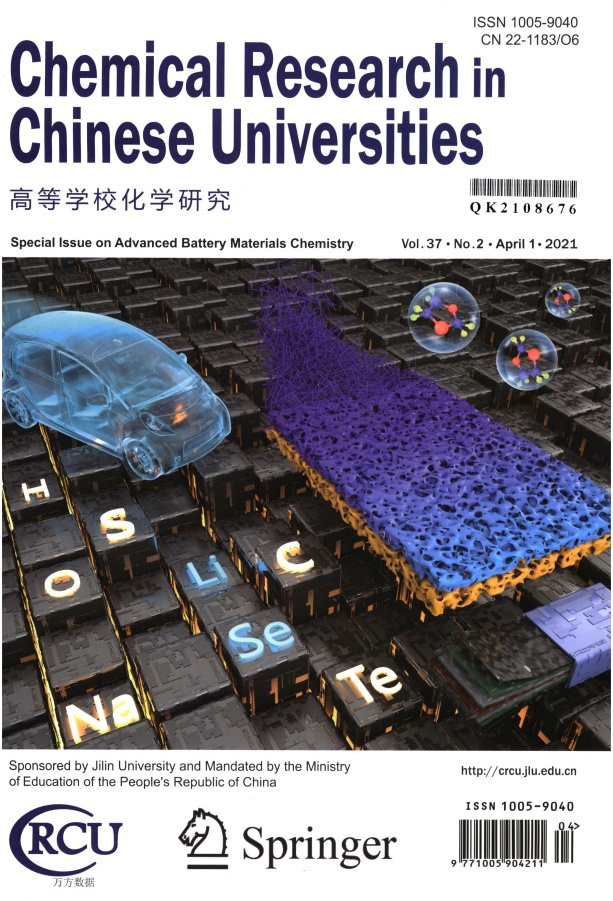
Chemical Research in Chinese Universities投稿地址
Chemical Research in Chinese Universities詳細信息
Chemical Research in Chinese Universities
Chemical Research in Chinese Universities
Chemical Research in Chinese Universities投稿要求
Chemical Research in Chinese Universities雜志投稿須知:
1、MANUSCRIPT SUBMISSIONWhen you first submit your paper, please upload the Word or PDF file. When your paper is accepted, you will be required to send the original source files. Submissions should be accompanied by a brief covering letter from the corresponding author. All correspondence, including the editor’s decision and request for revisions, will be done by e-mail. Chemical Research in Chinese Universities applies a non-refundable submission fee which the author(s) have to pay when the manuscript is ready to submit . If a paper is accepted for publication there will also be a publication fee.。
2、MANUSCRIPT PREPARATIONTitle: The paper title should be simple, concise and informative. Author(s): A list of all authors and their corresponding addresses with post codes for an effective mail delivery should be provided. The telephone and fax numbers (with country and area code) in addition to the e-mail address and the complete postal address of the corresponding author should be given. Abstract: An abstract is a summary of the content of the manuscript. Figures, tables, chemical structural formula, equations, reference citations should be avoided. Keywords: A list of 3-5 keywords should follow the abstract. Text: Organize the text as Introduction, Experimental, Results and Discussion, Acknowledgment and References. Physical quantities, units and symbols, etc., when used, should be consistent with the International System of Units (SI) and the Quantities and Units of the StateStandards of the People’s Republic of China. Latin and Greek Characters should be labeled. Figures and Tables: Figures and tables should be consecutively numbered with Arabic numerals in the order of in which they are mentioned in the text; each figure should have a descriptive legend. All illustrations should be in a finished form suitable for reproduction. No figures should exceed 10 cm×12 cm, which is large enough to take a reduction of 50%. Coordinate axes on figures should be labeled with the ordinate label written vertically and labels for quantities with dimensions should include units. Drawings should be of professional q uality or generated by high-resolution computer graphics. Equations: An equation is numerically numbered (Arabic numeral), and has the number put on its right side. References: References to the literature should be cited in the text by Arabic numerals in square brackets set on the text line, and listed numerically at the end of the paper. Style and punctuation of references should be in accordance with the following examples:[1]Hu S. Q., Huang K. K., Hou C. M., Yuang H. M., Hu B., Feng S. H., Chem. Res. Chinese Universities, 2010, 26(5), 675[2]Pines H., The Chemistry of Catalytic Hydrocarbon Conversion, Academic Press, New York, 1981, 170。
3、PEER REVIEWAll submissions will be reviewed by at least two referees selected by the editor. The author will be informed whether the manuscript is accepted within two months. If case of rejection, the manuscript won’t be returned to the authors. The revised manuscript must be sent to the editor within 50 days, from the date on which the editor sends the manuscript to the author, otherwise the editor will consider that the manuscript has been withdrawn by the author voluntarily.。
4、COPYRIGHT TRANSFERThe Copyright Transfer Statement must be returned to the Editorial Department of Chemical Research in Chinese Universities when the manuscript is accepted for publication.。
5、RESEARCH DATA POLICYThe journal encourages authors, where possible and applicable, to deposit data that support the findings of their research in a public repository. Authors and editors who do not have a preferred repository should consult Springer Nature’s list of reposi tories and research data policy.General repositories - for all types of research data - such as figshare and Dryad may also be used.Datasets that are assigned digital object identifiers (DOIs) by a data repository may be cited in the reference list. Data citations should include the minimum information recommended by DataCite: authors, title, publisher (repository name), identifier.DataCiteSpringer Nature provides a research data policy support service for authors and editorsThis service provides advice on research data policy compliance and on finding research data repositories. It is independent of journal, book and conference proceedings editorial offices and does not advise on specific manuscripts.
Chemical Research in Chinese Universities雜志簡介
《Chemical Research in Chinese Universities》1984年創刊,是中華人民共和國教育部委托吉林大學主辦的化學學科綜合性學術刊物。
《Chemical Research in Chinese Universities》由中華人民共和國教育部從全國重點高等院校和中國科學院聘請91位學術造詣精深的化學家組成學術陣容強大的編委會,由著名高分子化學家周其鳳院士任主編。
《Chemical Research in Chinese Universities》以研究論文、研究快報、研究簡報和綜合評述等欄目集中報道我國高等院校和中國科學院各研究所在化學學科及其交叉學科、新興學科和邊緣學科等領域所開展的基礎研究、應用研究和重大開發研究所取得的最新成果。
《Chemical Research in Chinese Universities》以“新、快、高”(即選題內容新,文章發表速度快和學術水平及編輯出版質量高)為辦刊特色,刊載國家自然科學基金、攀登計劃、“八六三”和“九七三”計劃資助項目及其它科學基金資助項目成果文章達90%以上。
《Chemical Research in Chinese Universities》曾獲1996年國家教委優秀科技期刊二等獎、1999年全國優秀高等學校自然科學學報及教育部優秀科技期刊評比一等獎。
Chemical Research in Chinese Universities統計分析
影響因子:指該期刊近兩年文獻的平均被引用率,即該期刊前兩年論文在評價當年每篇論文被引用的平均次數
被引半衰期:衡量期刊老化速度快慢的一種指標,指某一期刊論文在某年被引用的全部次數中,較新的一半被引論文刊載的時間跨度
他引率:期刊被他刊引用的次數占該刊總被引次數的比例用以測度某期刊學術交流的廣度、專業面的寬窄以及學科的交叉程度
引用半衰期:指某種期刊在某年中所引用的全部參考文獻中較新的一半是在最近多少年時段內刊載的
平均引文數:在給定的時間內,期刊篇均參考文獻量,用以測度期刊的平均引文水平,考察期刊吸收信息的能力以及科學交流程度的高低
熱門評論
投稿接受后還有多次校稿,編輯老師非常仔細,也是很好的學習的過程。因為被拒審三次,拖的時間比較長,問編輯部進展,編輯部很快回信說初步接受,可以給刊用通知,也很快收到了。給個贊!
在投稿后打電話到編輯部希望能快點審回來,編輯答應送審比較快的專家審稿。放假回來,就收到審稿意見(修改后再審)。專家指出的問題確實讓我心悅誠服。按意見仔細修改后,1月初就收到了錄用通知。整個過程還是比較順利。
投稿網送貨也快,這個服務也是很好的,并且雜志都是新的,文章質量很好,很權威,包裝也很好,內容很豐富,很滿意的,謝謝賣家。下次會回購的!
7月13號投了這個雜志,9月9號發郵件表示初步錄用,按照錄用通知單進行修改,還要求提供全文中文譯稿。修改用時一個月,一周之后通知錄用。審稿速度很快,要求文章有創新點。然后就是根據修改意見認真修改,編輯很好,中間多次打電話問相關事情,都很耐心,熱情解答。
3月初投稿,5月初就收到了錄用通知。審稿周期相對還是比較快的。退修的時候,三個審稿人中,其中兩個給的審稿意見都比較中肯,還有一個明顯沒看文章。總之,投稿過程還是比較順利。
Chemical Research in Chinese Universities雜志內容權威性比較高,采編團隊強大,可讀性很高。投稿網賣的雜志挺齊全的噢。以后買雜志在這選就ok了。呵呵!!
審稿速度很快,一個月多一點專家意見返回了,是小修,改回之后很快就收到了采用通知,個人感覺效率很高,評審意見中對論文的一些細節都提出了很嚴謹的要求,反而對于文章的內容和結論都沒有改動和質疑的地方。
很幸運的是在老師指導下,多次修改。文章被雜志收錄了,對我是個很大的激勵。審稿老師的意見很是中肯,對文章內容修改相當細致。編輯老師態度也很好,不厭其煩的幫我分析。希望雜志越辦越好。
本人第一次投了一篇關于高教發展戰略雜志的文章。今天收到拒稿消息,雖然有點小失落,但是審稿速度挺快的,而且審稿意見很中肯,對文章的修改有很大的幫助。編輯態度也超好。是一個很不錯的南大核心雜志。
之前投了兩篇,都中了,感覺還是比較好中,不錯的雜志!審稿人所提問題很犀利,非常專業!編輯很敬業,校稿非常仔細。個人覺得文章有點新意的,論據充分的,接收的可能性還是蠻大的。推薦大家投稿。
相關問題
- Chemical Research in Chinese Universities是正規期刊嗎?
- Chemical Research in Chinese Universities是什么級別的期刊?是核心期刊嗎?
- Chemical Research in Chinese Universities評職稱可以嗎?單位認可嗎?
- Chemical Research in Chinese Universities是北大核心嗎?是中文核心嗎?
- Chemical Research in Chinese Universities是科技核心嗎?
- Chemical Research in Chinese Universities是統計源核心嗎?
- Chemical Research in Chinese Universities是南大核心CSSCI嗎?
- Chemical Research in Chinese Universities是CSCD期刊嗎?
- Chemical Research in Chinese Universities是國家級期刊嗎?
- Chemical Research in Chinese Universities是SCD期刊嗎?
- Chemical Research in Chinese Universities是國家新聞出版署第一批、第二批學術期刊嗎?
- Chemical Research in Chinese Universities好投嗎?Chemical Research in Chinese Universities簡介
相關期刊
更多常見問題
| Q:論文發表的時候可以一稿多投嗎? |
| A:一稿多投的行為是典型的學術不端的行為,是國內外學術界都明令禁止的行為,原因主要在于涉及到文章版權歸屬的問題,如果作者的文章已經被某個雜志社錄用,或者同時被兩家雜志社錄用,就會涉及到版權糾紛,作為雜志社都會保護本社的合法權益,到這時作者就會比較麻煩,吃官司都是小事兒了,被打入黑名單降級降職影響可就太大了。 |
| Q:職稱論文發表對時間有限制嗎? |
| A:職稱論文發表并沒有明確規定截止時間,需要作者結合自己所在地區的具體規定自己安排發表時間,一般職稱評審,各地區都會明確規定申報材料的最后期限和截止日期,我們結合這個日期來考慮何時發表文章就可以,大部分地區職稱評審都集中在每年的8-10月之間,有的地區要求7月中旬開始交材料,最晚8月底之前,有的則是要求8月中旬交,還有部分地區要求截止時間為申報時間上年的12月31日,所以,各個地區的具體要求并不同,申報者需要在提交材料前確保自己的文章已經見刊并且被相應的數據庫檢索即可。 |
| Q:網上發表論文如何防騙?可靠網站與可疑網站如何區分? |
| A:由于發表論文的需求遠遠多于雜志版面的供應,再加上眾所周知的審稿難!審稿慢!選擇論文發表網站發表表論文確實能解決以上問題。賣方市場的出現加之發表論文的剛性需求,就導致出現先付款后發表的現狀。論文發表網站正規與否是通過網站從始至終所提供服務體現出來的,任何交易只要存在時間差都會有風險,但這個風險是可以通過您的智慧來避免的。因為不是所有論文網站都是騙子,你要做的就是過濾掉沒保障的網站,選擇可靠的論文發表網站! |
| Q:一般期刊需要提前多久準備? |
| A:省級、國家級期刊建議至少提前6個月準備。一般來講,雜志社為了確保每期雜志正常出刊,都會提前將當期之后1-3個月的稿件提前安排好,而一些創刊較早,認可度更高的熱門期刊,來稿量較大,發表周期可能就會更久。提前準備,意味著雜志的可選擇性更多。 |
| Q:核心期刊需要提前多久準備? |
| A:核心期刊建議至少提前12個月準備,核心期刊正常的審稿周期為1-3個月,且審核嚴格,退稿、返修幾率更大,這意味著在流程上耗費的時間更久,且核心期刊版面有限,投稿競爭更加激烈,即使被錄用,排刊也比普通期刊晚很多,因此需要更早準備。 |






